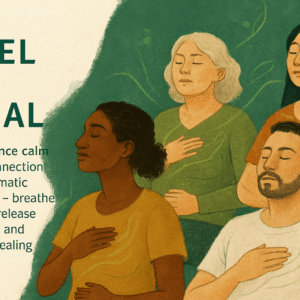Sure — here’s a fully expanded, SEO-optimized blog (1,450+ words) based on your provided content and URL. It naturally integrates keywords like yoga breathwork, pranayama, conscious breathing, stress relief, and mindful wellness, while keeping it educational, warm, and engaging.
Yoga Breathwork: The Art of Conscious Breathing for Mind-Body Harmony
Source: https://biodynamicbreath.com/blogs/yoga-breathwork/
We all breathe—yet few of us truly understand the deeper wisdom our breath holds. Every inhale and exhale is more than just a biological act; it’s a conversation between body, mind, and spirit. Yoga breathwork, also known as pranayama, invites us to listen closely to that conversation and use it as a powerful tool for balance, vitality, and awareness.
Whether you’re brand new to yoga or simply curious about holistic healing, this guide will help you explore what yoga breathwork is, how it works, and how to safely begin your journey toward more conscious breathing.
What Is Yoga Breathwork? Understanding the Basics
At its core, yoga breathwork is the ancient practice of controlling and observing the breath with mindfulness. The Sanskrit word pranayama comes from prana (life force or energy) and yama (control or discipline). In yogic philosophy, the breath is seen as the bridge between the physical body and the mind—between what we can touch and what we can feel.
When we consciously regulate our breath, we influence our autonomic nervous system, shifting the body from a reactive “fight or flight” mode into a calm, restorative state. Modern science has now validated what yogis have practiced for centuries: slow, rhythmic breathing reduces stress hormones, balances blood pressure, improves lung capacity, and enhances focus.
The breath becomes both a mirror and a medicine—reflecting our emotional state and offering the means to transform it.
Popular Yoga Breathwork Techniques
There are many styles of pranayama, each with unique benefits for the body and mind. Here are a few foundational techniques to explore:
- Ujjayi Pranayama (Victorious Breath) – A slow, ocean-like breathing technique that promotes focus and calm, often used during flowing yoga sequences.
- Nadi Shodhana (Alternate Nostril Breathing) – Balances the left and right hemispheres of the brain, encouraging harmony and inner equilibrium.
- Sama Vritti (Box Breathing) – Involves equal-length inhalation, retention, exhalation, and suspension, cultivating steadiness and peace.
- Kapalabhati (Skull-Shining Breath) – A more energizing, detoxifying technique that clears the mind and awakens the body.
- Bhramari (Humming Bee Breath) – Uses a gentle humming sound to calm the nervous system and release emotional tension.
Each technique has a rhythm of its own, but all share a common purpose: to connect breath, awareness, and presence.
Why Yoga Breathwork Matters — Especially Today
In an age of constant connectivity, stress, and distraction, our breathing patterns often mirror our hurried lives—shallow, uneven, and rushed. Yoga breathwork offers a powerful counterbalance: it invites stillness, clarity, and restoration.
Physically, pranayama strengthens the respiratory system, improves oxygen circulation, and supports cardiovascular health. It also assists in regulating blood pressure and boosting immunity.
Mentally and emotionally, conscious breathing enhances focus, reduces anxiety, and helps us process emotions more clearly. Studies have shown that consistent breathwork practice can significantly lower cortisol levels (the stress hormone) and increase feelings of well-being.
Beyond the physical and mental, yoga breathwork offers a spiritual dimension—it reconnects us to the essence of life itself. Every breath becomes a reminder of presence, gratitude, and connection to the greater whole.
Modern Applications of Yoga Breathwork
Yoga breathwork is no longer confined to yoga studios. It’s now part of many wellness innovations and therapeutic approaches around the world:
- Corporate wellness programs use breathwork to combat burnout and boost productivity.
- Therapists integrate pranayama with mindfulness for trauma and stress recovery.
- Apps and online platforms guide users through short breathwork sessions for better sleep and emotional balance.
- Retreats and workshops, like those offered at Biodynamic Breathwork, combine conscious breathing with movement and body awareness to release deep emotional tension.
This integration shows how timeless breathwork truly is—it evolves with us, meeting the needs of modern life without losing its ancient essence.
How to Get Started Safely with Yoga Breathwork
Breathwork is safe for most people, but like all wellness practices, it’s important to approach it with mindfulness and respect for your body’s limits. Here’s how to begin:
1. Preparation & Mindset
- Find a quiet, comfortable place where you won’t be disturbed.
- Sit upright with your spine elongated, shoulders relaxed, and jaw soft.
- Begin with an open mind and a gentle intention—presence, not perfection.
2. Start Small
Even five minutes a day can create noticeable change. Pick one technique and practice it consistently for a week before exploring others.
3. Foundational Practices
Try these beginner-friendly techniques:
- Diaphragmatic (Belly) Breathing: Place one hand on your belly. Inhale slowly through your nose, allowing your belly to rise; exhale gently through your mouth.
- Box Breathing (Sama Vritti): Inhale for 4 counts, hold for 4, exhale for 4, hold again for 4.
- Alternate Nostril (Nadi Shodhana): Close your right nostril, inhale through your left, switch and exhale through your right. Repeat slowly.
- Ujjayi Breath: Slightly constrict the throat and breathe through the nose, creating a soothing, wave-like sound.
4. Safety Guidelines
- Stop if you feel lightheaded or strained.
- Avoid long breath holds if you’re new to the practice.
- Consult a doctor if you have respiratory or cardiac conditions, or if you’re pregnant.
The beauty of breathwork lies in its gentleness—there’s no competition, no performance, only awareness.
Integrating Breathwork into Daily Life
Once you’ve developed a basic routine, you can begin to weave breath awareness into every part of your day.
Try these simple integrations:
- Morning reset: Begin your day with 10 deep, slow breaths to center your mind.
- During work: Practice 2 minutes of box breathing before meetings to reduce stress.
- Evening unwind: Use humming breath (Bhramari) to calm your nervous system before bed.
- Movement: Sync breath with gentle yoga poses or stretching.
Keeping a breathwork journal can help you observe changes in mood, focus, and energy. Over time, you’ll notice patterns that encourage consistency and growth.
As you become more comfortable, consider exploring guided sessions or workshops with trained instructors. A professional setting, like those at Biodynamic Breathwork, can safely guide you through deeper emotional and energetic releases.
FAQs About Yoga Breathwork
How long should I practice each day?
Start with 5–10 minutes daily. Gradually increase as your comfort grows.
Can I do breathwork without yoga postures?
Yes! Pranayama can be practiced anytime, anywhere—no yoga mat required.
When will I start to see results?
Many people feel calmer and more focused after their first session. Lasting benefits like better sleep, emotional balance, and energy regulation emerge with consistent practice over a few weeks.
A Final Word: The Breath as Your Ally
Yoga breathwork is not just another wellness trend—it’s an invitation to come home to yourself. With each inhale, you draw in energy and clarity; with each exhale, you release tension and noise. Over time, this simple rhythm can transform how you experience life—from stress and chaos to stillness and flow.
Whether your goal is relaxation, energy, or deeper spiritual connection, remember: your breath is always with you—a free, natural, and profound tool for transformation.
About Biodynamic Breathwork
At Biodynamic Breathwork, we believe that healing begins with awareness. Our approach combines conscious breathing with bodywork, movement, and emotional release to help you reconnect with your inner vitality.
Explore our guided sessions, workshops, and retreats designed to support your mind-body harmony and personal growth.
Contact Us
📧 Email: info@biodynamicbreath.com
📞 Phone: +1 (310) 598-7495
🌐 Website: www.biodynamicbreath.com
We’re here to support your journey into conscious breathing, self-awareness, and holistic well-being.







